Kia Borrego 2015 Owner's Manual
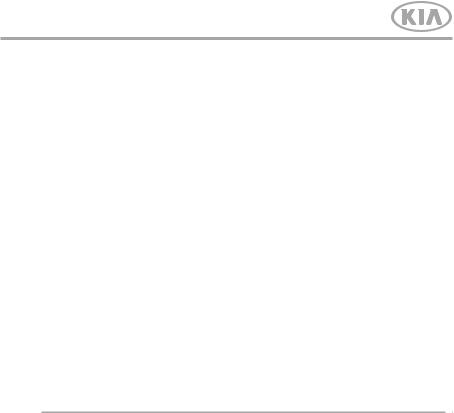
KIA, THE COMPANY
ThankyouforbecomingtheownerofanewKiavehicle.
Asaglobalcarmanufacturerfocusedonbuildinghigh-quality,valuefor moneyprices,KiaMotorsisdedicatedtoprovidingyouwithacustomer serviceexperiencethatexceedsyourexpectations.
AtallofourKiadealershipsyouwillbetreatedwithwarmth,hospitality andprofessionalismbypeoplewhocarebasedonour“Family-likeCare” promise.
All information contained in this Owner’s Manual was accurate at the time of publication. However, Kia reserves the right to make changes atanytimesothatourpolicyofcontinualproductimprovementcanbe carriedout.
Thismanualappliestoallmodelsofthisvehicleandincludesdescriptionsandexplanationsofoptionalaswellasstandardequipment.Asa result,youmayencountermaterialinthismanualthatisnotapplicable toyourspecificKiavehicle.
EnjoyyourvehicleandKia’s“Family-likeCare”experience! 
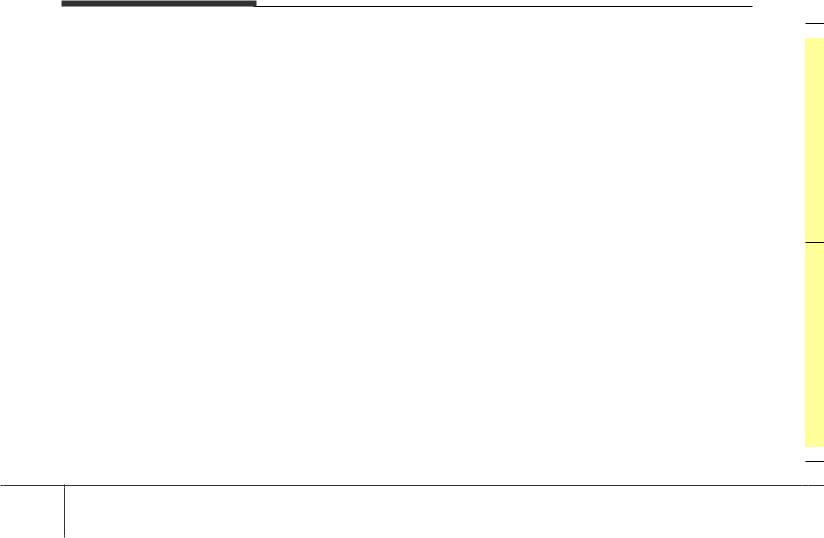
F O R E W O R D
ThankyouforchoosingaKIAvehicle.
When you require service, remember that your dealer knowsyourvehiclebest.Yourdealerhasfactory-trained technicians, recommended special tools, genuine KIA replacement parts and is dedicated to your complete satisfaction.
Because subsequent owners require this important information as well, this publication should remain with the vehicleifitissold.
Thismanualwillfamiliarizeyouwithoperational,maintenanceandsafetyinformationaboutyournewvehicle.It is supplemented by a Warranty and Maintenance book that provides important information on all warranties regardingyourvehicle.Weurgeyoutoreadthesepublicationscarefullyandfollowtherecommendationstohelp assureenjoyableandsafeoperationofyournewvehicle.
KIA offers a great variety of options, components and features for its various models. Therefore, some of the equipmentdescribedinthismanual,alongwiththevariousillustrations,maynotbeapplicabletoyourparticular vehicle.
Theinformationandspecificationsprovidedinthismanual were accurate at the time of printing. KIAreserves therighttodiscontinueorchangespecificationsordesign at any time without notice and without incurring any obligation.Ifyouhavequestions,alwayscheckwithyour authorizedKIAdealer.
We assure you of our continuing interest in your motoringpleasureandsatisfactioninyourKIAvehicle.
©2014KIAMOTORSCorp.
All rights reserved. Reproduction by any means, electronicormechanical,includingphotocopying,recording, or by any information storage and retrieval system or translationinwholeorpartisnotpermittedwithoutwrittenauthorizationfromKIAMOTORSCorporation.
PrintedinKorea
i

TABLE OF CONTENTS 
Introduction |
|
1 |
|
|
|
|
|
|
Your vehicle at a glance |
|
2 |
|
|
|
|
|
|
Safety features of your vehicle |
|
3 |
|
|
|
|
|
|
Features of your vehicle |
|
4 |
|
|
|
|
|
|
Driving your vehicle |
|
5 |
|
|
|
|
|
|
What to do in an emergency |
|
6 |
|
|
|
|
|
|
Maintenance |
|
7 |
|
|
|
|
|
|
Specifications & Consumer information |
|
8 |
|
|
|
|
|
|
Index |
|
I |
|
|
|
ii

Introduction |
|
1 |
|
|
|
How to use this manual / 1-2
Fuel requirements / 1-2
Vehicle handling instructions / 1-6
Vehicle break-in process / 1-6
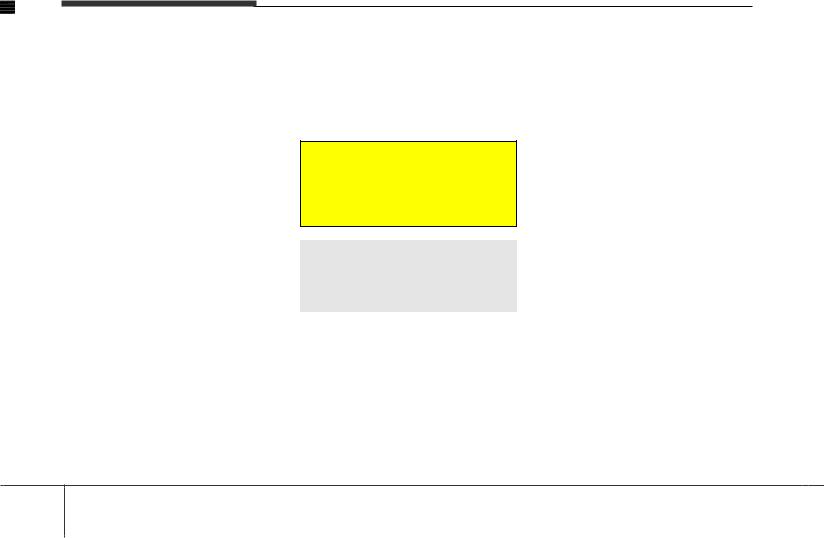
INTRODUCTION
HOW TO USE THIS MANUAL
A010000AHM
We want to help you get the greatest possible driving pleasure from your vehicle. Your Owner’s Manual can assist you in many ways. We strongly recommend that you read the entire manual. In order to minimize the chance of death or injury, you must read the WARNING and CAUTION sections in the manual.
Illustrations complement the words in this manual to best explain how to enjoy your vehicle. By reading your manual, you learn about features, important safety information, and driving tips under various road conditions.
The general layout of the manual is provided in the Table of Contents. Use the index when looking for a specific area or subject; it has an alphabetical listing of all information in your manual.
Sections: This manual has eight sections plus an index. Each section begins with a brief list of contents so you can tell at a glance if that section has the information you want.
You will find various WARNINGs, CAUTIONs, and NOTICEs in this manual. These WARNINGs were prepared to enhance your personal safety. You should carefully read and follow ALL procedures and recommendations provided in these WARNINGs, CAUTIONs and NOTICEs.
WARNING
A WARNING indicates a situation in which harm, serious bodily injury or death could result if the warning is ignored.
CAUTION
A CAUTION indicates a situation in which damage to your vehicle could result if the caution is ignored.
NOTICE
ANOTICEindicatesinterestingorhelpfulinformationisbeingprovided.
FUEL REQUIREMENTS
Gasoline engine
A020101AHM
Unleaded
Your new Kia vehicle is designed to use only unleaded fuel having an Octane Rating of RON (Research Octane Number) 91 / AKI (Anti-Knock Index) 87 or higher. (Do not use methanol blended fuels)
Your new vehicle is designed to obtain maximum performance with UNLEADED FUEL, as well as minimize exhaust emissions and spark plug fouling.
1 2
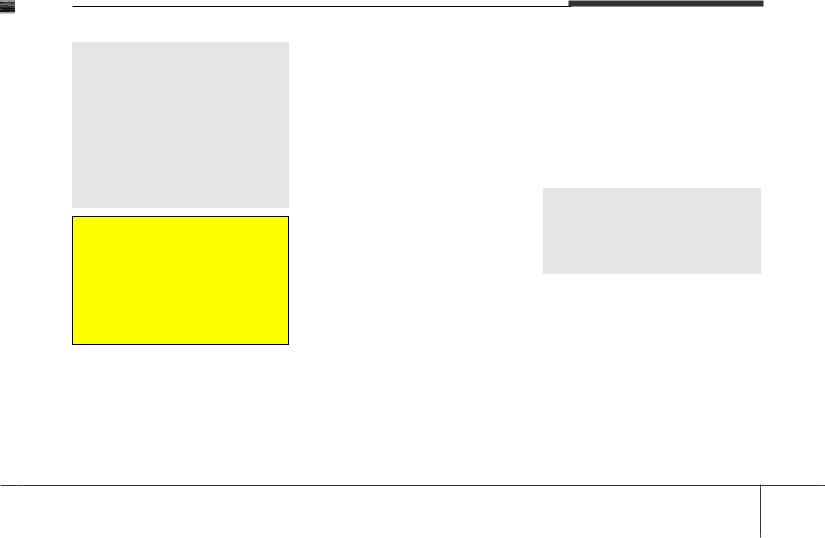
CAUTION
NEVER USE LEADED FUEL. The use of leaded fuel is detrimental to the catalytic converter and will damage the engine control system’s oxygen sensor and affect emission control.
Never add any fuel system cleaning agents to the fuel tank other than what has been specified. (Consult an authorized Kia dealer for details.)
WARNING
•Do not "top off" after the nozzle automatically shuts off when refueling.
•Always check that the fuel cap is installed securely to prevent fuel spillage in the event of an accident.
A020102AHM
Leaded (if equipped)
For some countries, your vehicle is designed to use leaded gasoline. When you are going to use leaded gasoline, ask an authorized Kia dealer whether leaded gasoline in your vehicle is available or not.
Octane Rating of leaded gasoline is same with unleaded one.
A020103AUN
Gasoline containing alcohol and methanol
Gasohol, a mixture of gasoline and ethanol (also known as grain alcohol), and gasoline or gasohol containing methanol (also known as wood alcohol) are being marketed along with or instead of leaded or unleaded gasoline.
Do not use gasohol containing more than 10% ethanol, and do not use gasoline or gasohol containing any methanol. Either of these fuels may cause drivability problems and damage to the fuel system, engine control system and emission control system.
INTRODUCTION
Discontinue using gasohol of any kind if drivability problems occur.
Vehicle damage or drivability problems may not be covered by the manufacturer’s warranty if they result from the use of:
1.Gasohol containing more than 10% ethanol.
2.Gasoline or gasohol containing methanol.
3.Leaded fuel or leaded gasohol.
CAUTION
Never use gasohol which contains methanol. Discontinue use of any gasohol product which impairs drivability.
1 3

INTRODUCTION
Other fuels
Using fuels such as
-Silicone (Si) contained fuel,
-MMT (Manganese, Mn) contained fuel,
-Ferrocene (Fe) contained fuel, and
-Other metalic additives contained fuels, may cause vehicle and engine damage or cause plugging, misfiring, poor acceleration, engine stalling, catalyst melting, abnormal corrosion, life cycle reduction, etc.
Also, the Malfunction Indicator Lamp (MIL) may illuminate.
NOTICE
Damage to the fuel system orperformanceproblemcausedbytheuseofthese fuels may not be covered by your New VehicleLimitedWarranty.
A020104AUN
Use of MTBE
Kia recommends avoiding fuels containing MTBE (Methyl Tertiary Butyl Ether) over 15.0% vol. (Oxygen Content 2.7% weight) in your vehicle.
Fuel containing MTBE over 15.0% vol. (Oxygen Content 2.7% weight) may reduce vehicle performance and produce vapor lock or hard starting.
CAUTION
Your New Vehicle Limited Warranty may not cover damage to the fuel system and any performance problems that are caused by the use of fuels containing methanol or fuels containing MTBE (Methyl Tertiary Butyl Ether) over 15.0% vol. (Oxygen Content 2.7% weight.)
A020105AUN
Do not use methanol
Fuels containing methanol (wood alcohol) should not be used in your vehicle. This type of fuel can reduce vehicle performance and damage components of the fuel system, engine control system and emission control system.
A020106AUN
Fuel Additives
Kia recommends that you use unleaded gasoline which has an Octane Rating of RON (Research Octane Number) 91 / AKI (Anti-Knock Index) 87 or higher.
For customers who do not use good quality gasolines including fuel additives regularly, and have problems starting or the engine does not run smoothly, one bottle of additives added to the fuel tank at every 15,000km (For Europe)/ 5,000km (Except Europe). Additives are available from your authorized Kia dealer along with information on how to use them. Do not mix other additives.
A020107AUN
Operation in foreign countries
If you are going to drive your vehicle in another country, be sure to:
•Observe all regulations regarding registration and insurance.
•Determine that acceptable fuel is available.
1 4

Diesel engine
A020201DHM
Diesel fuel
Diesel engine must be operated only on commercially available diesel fuel that complies with EN 590 or comparable standard. (EN stands for "European Norm"). Do not use marine diesel fuel, heating oils, or non-approved fuel additives, as this will increase wear and cause damage to the engine and fuel system. The use of non-approved fuels and / or fuel additives will result in a limitation of your warranty rights.
Diesel fuel of above cetane 51 is used in your vehicle. If two types of diesel fuel are available, use summer or winter fuel properly according to the following temperature conditions.
•Above -5°C(23°F) ... Summer type diesel fuel.
•Below -5°C(23°F) ... Winter type diesel
fuel.
Watch the fuel level in the tank very carefully : If the engine stops through fuel failure, the circuits must be completely purged to restart.
CAUTION
Do not let any gasoline or water enter the tank. This would make it necessary to drain it out and to bleed the lines to avoid jamming the injection pump and damaging the engine.
CAUTION - Diesel Fuel (if equipped with DPF)
It is recommended to use the regulated automotive diesel fuel for diesel vehicle equipped with the DPF system.
If you use diesel fuel including high sulfur (more than 50 ppm sulfur) and unspecified additives, it can cause the DPF system to be damaged and white smoke can be emitted.
INTRODUCTION
Biodiesel
Commercially supplied Diesel blends of no more than 7% biodiesel, commonly known as "B7 Diesel" may be used in your vehicle if Biodiesel meets EN 14214 or equivalent specifications. (EN stands for "European Norm"). The use of biofuels exceeding 7% made from rapeseed methyl ester (RME), fatty acid methyl ester (FAME), vegetable oil methyl ester (VME) etc. or mixing exceeding 7% diesel with biodiesel will cause increased wear or damage to the engine and fuel system. Repair or replacement of worn or damaged components due to the use of non approved fuels will not be covered by the manufactures warranty.
1 5

INTRODUCTION
Biodiesel (for New Zealand)
Commercially supplied Diesel blends of no more than 7% biodiesel, commonly known as "B7 Diesel" may be used in your vehicle if Biodiesel meets EN 14214 or equivalent specifications. (EN stands for "European Norm"). The use of biofuels exceeding 7%, made from rapeseed methyl ester (RME), vegetable oil methyl ester (VME) etc. or mixing diesel exceeding 7% with biodiesel will cause increased wear or damage to the engine and fuel system. Repair or replacement of worn or damaged components due to the use of non approved fuels will not be covered by the manufactures warranty.
CAUTION
•Never use any fuel, whether diesel, B7 biodiesel or otherwise, that fails to meet the latest petroleum industry specification.
•Never use any fuel additives or treatments that are not recommended or approved by the vehicle manufacturer.
VEHICLE HANDLING
INSTRUCTIONS
A090000AEN
As with other vehicles of this type, failure to operate this vehicle correctly may result in loss of control, an accident or vehicle rollover.
Specific design characteristics (higher ground clearance, track, etc.) give this vehicle a higher center of gravity than other types of vehicles. In other words they are not designed for cornering at the same speeds as conventional 2-wheel drive vehicles. Avoid sharp turns or abrupt maneuvers. Again, failure to operate this vehicle correctly may result in loss of control, an accident or vehicle rollover. Be sure to read the “Reducing the risk of a rollover” driving guidelines, in section 5 of this manual.
VEHICLE BREAK-IN PROCESS
A030000AUN
No special break-in period is needed. By following a few simple precautions for the first 1,000 km (600 miles) you may add to the performance, economy and life of your vehicle.
•Do not race the engine.
•While driving, keep your engine speed (rpm, or revolutions per minute) between 2,000 rpm and 4,000 rpm.
•Do not maintain a single speed for long periods of time, either fast or slow. Varying engine speed is needed to properly break-in the engine.
•Avoid hard stops, except in emergencies, to allow the brakes to seat properly.
•Don't tow a trailer during the first 2,000 km (1,200 miles) of operation.
1 6

Your vehicle at a glance |
|
2 |
|
|
|
|
|
|
Interioroverview/2-2
Instrumentpaneloverview/2-3
Enginecompartment/2-4
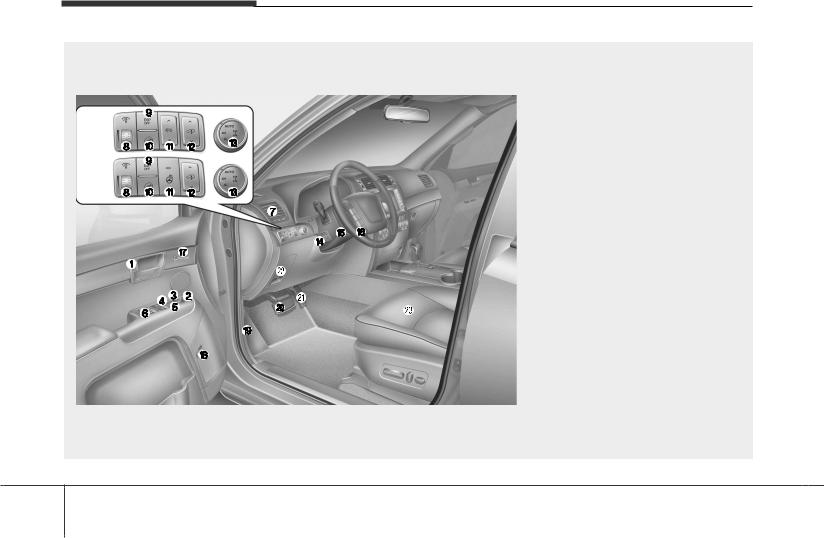
Yourvehicleataglance
INTERIOR OVERVIEW
|
1. Door lock/unlock button .................... |
|
4-15 |
|
|
2. Outside rearview mirror folding |
|
||
|
button*............................................... |
|
4-46 |
|
|
3. Outside rearview mirror control |
|
||
|
switch ................................................ |
|
4-45 |
|
■ Type A |
4. Central door lock switch.................... |
|
4-15 |
|
|
5. Power window lock button ................ |
|
4-23 |
|
|
6. Power window switches .................... |
|
4-20 |
|
■ Type B |
7. Air vent.............................................. |
|
4-94 |
|
|
8. Instrument panel illumination control |
|
||
|
knob* or Head lamp leveling device* |
|
||
|
................................................. |
|
4-49, 4-79 |
|
|
9. ESP OFF button* ............................. |
|
5-33 |
|
|
10. DBC button* .................................... |
|
5-37 |
|
|
11. |
Power adjustable pedal control switch* |
||
|
|
or Heated steering wheel button* |
|
|
|
|
................................................ |
4-36,4-38 |
|
|
12. |
ALS control switch* ......................... |
|
5-41 |
|
13. |
4WD transfer shift knob*................. |
|
5-19 |
|
14. |
Steering wheel tilt control* .............. |
|
4-38 |
|
15. |
Heated steering wheel button* ....... |
4-38 |
|
|
16. |
Steering wheel ................................ |
|
4-37 |
|
17. Driver position memory |
|
|
|
|
|
system button* ................................ |
|
4-33 |
|
18. |
Fuel filler lid release lever ............... |
|
4-26 |
|
19. |
Hood release lever.......................... |
|
4-24 |
|
20. Brake pedal..................................... |
|
5-28 |
|
|
21. |
Accelerator pedal .............................. |
|
5-8 |
|
22. Fuse box ......................................... |
|
7-46 |
|
|
23. |
Seat................................................... |
|
3-2 |
|
* : if equipped |
OHM013001L |
||
|
|
|
||
B010000CHM-EE
2 2
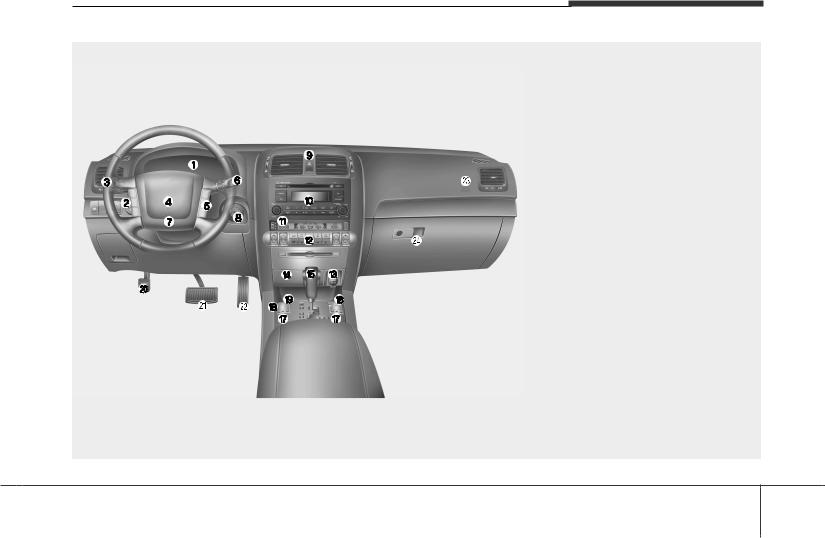
Yourvehicleataglance
INSTRUMENT PANEL OVERVIEW
1. |
Instrument cluster............................. |
4-47 |
|
2. |
Steering wheel audio controls* ...... |
4-129 |
|
3. |
Light control / Turn signals ............... |
4-75 |
|
4. Horn ................................................. |
4-39 |
||
5. |
Auto cruise controls* ........................ |
5-44 |
|
6. Wiper/Washer switch........................ |
4-81 |
||
7. |
Driver’s front air bag ......................... |
3-48 |
|
8. |
Ignition switch* or |
|
|
|
ENGINE START/STOP button* ... |
5-4, 5-6 |
|
9. |
Hazard warning flasher ...................... |
6-2 |
|
10. |
Audio*........................................... |
4-135 |
|
11. |
Digital clock .................................. |
4-123 |
|
12. |
Climate control system* ................. |
4-90 |
|
13. |
Power outlet* ................................ |
4-122 |
|
14. |
Cigar lighter and ashtray .............. |
4-120 |
|
15. |
Shift lever ....................................... |
5-12 |
|
16. AUX, USB and iPod port*............. |
4-132 |
||
17. |
Front seat warmer/Seat air ventilation |
||
|
|
switch ............................................... |
3-9 |
18. Rear parking assist system |
|
||
|
|
OFF switch*.................................... |
4-67 |
19. |
Rear fog light switch* ..................... |
4-79 |
|
20. |
Parking brake pedal ....................... |
5-29 |
|
21. Brake pedal .................................... |
5-28 |
||
22. |
Accelerator pedal ............................. |
5-8 |
|
23. |
Passenger’s front air bag* .............. |
3-48 |
|
24. Glove box ..................................... |
4-117 |
||
* : if equipped |
|
||
OHM018002L
B020000CHM-EE
2 3
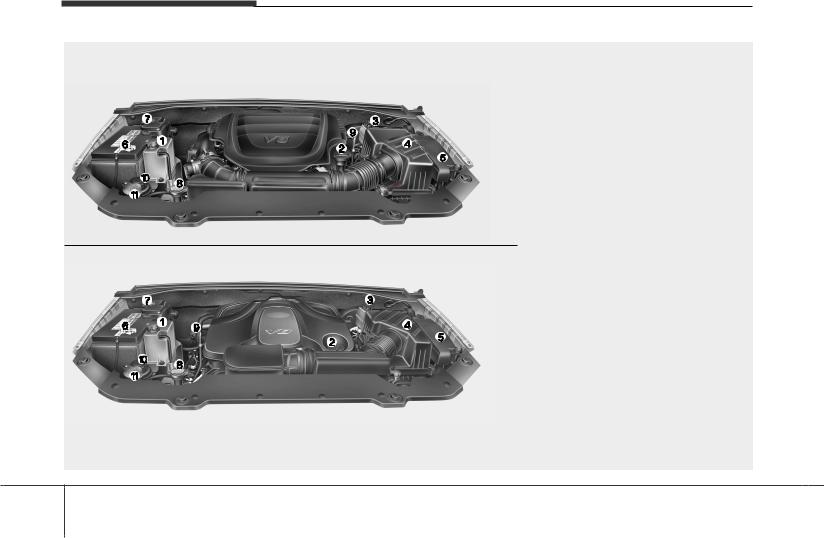
Yourvehicleataglance
ENGINE COMPARTMENT
■ Gasoline Engine (3.8L)
■ Gasoline Engine (4.6L)
1. |
Engine coolant reservoir ................. |
7-20 |
2. |
Engine oil filler cap.......................... |
7-18 |
3. |
Brake fluid reservoir ........................ |
7-22 |
4. |
Air cleaner....................................... |
7-26 |
5. Fuse box ......................................... |
7-45 |
|
6. |
Negative battery terminal................ |
7-32 |
7. |
Positive battery terminal ................. |
7-32 |
8. |
Radiator cap.................................... |
7-21 |
9. |
Engine oil dipstick ........................... |
7-18 |
10. Power steering fluid reservoir ....... |
7-23 |
|
11. Windshield washer fluid reservoir .7-24
* The actual engine room in the vehicle may differ from the illustration.
OHM018005N/OHM018004N
B030000AHM-EE
2 4
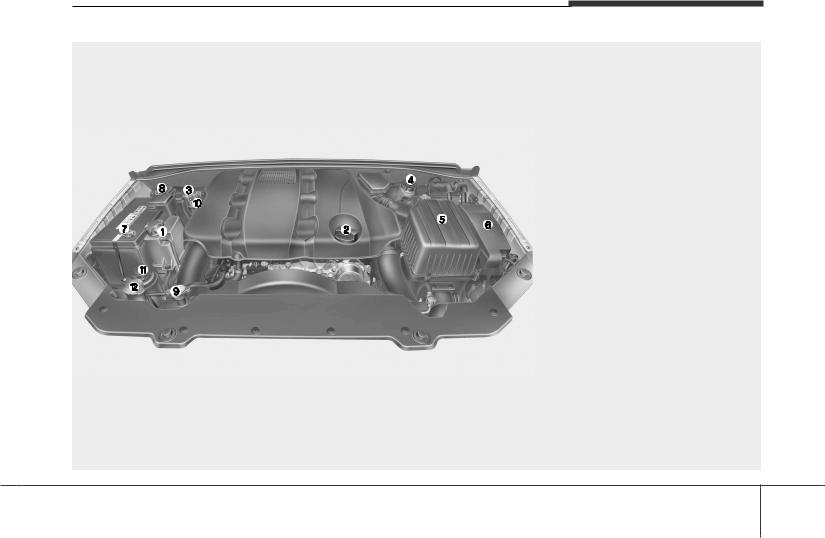
Yourvehicleataglance
■ Diesel Engine (3.0L)
1. |
Engine coolant reservoir.................. |
7-20 |
2. |
Engine oil filler cap .......................... |
7-18 |
3. |
Fuel filter .......................................... |
7-25 |
4. |
Brake fluid reservoir......................... |
7-22 |
5. |
Air cleaner ....................................... |
7-26 |
6. Fuse box .......................................... |
7-45 |
|
7. |
Negative battery terminal ................ |
7-32 |
8. |
Positive battery terminal .................. |
7-32 |
9. |
Radiator cap .................................... |
7-21 |
10. Engine oil dipstick .......................... |
7-18 |
|
11. Power steering fluid reservoir ........ |
7-23 |
|
12. Windshield washer fluid reservoir .. |
7-24 |
|
* The actual engine room in the vehicle may differ from the illustration.
OHM013003
2 5

Seats/3-2
Seatbelts/3-21
Childrestraintsystem/3-33
Airbag-supplementalrestraintsystem/3-42
|
Safety features of your vehicle |
|
3 |
|
|
|
|
|
|
|
|
|
|
|
|
|
|
|
|
|
|
|
|
|
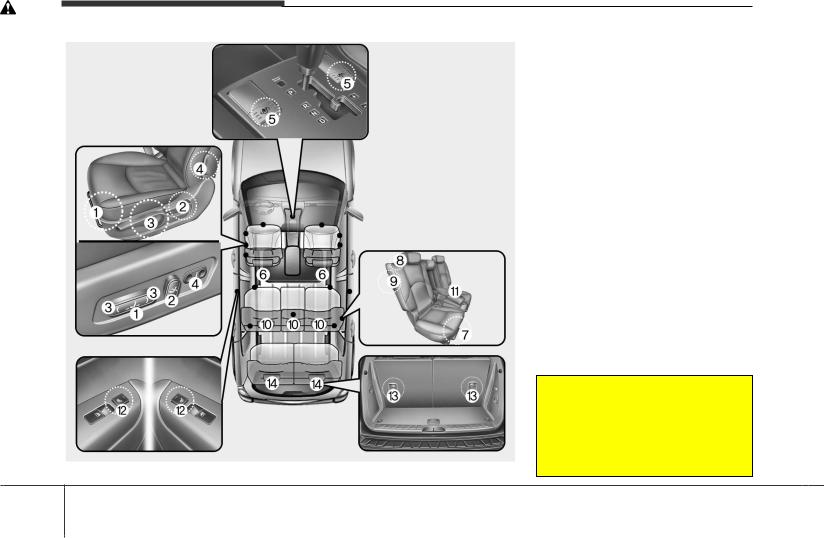
Safetyfeaturesofyourvehicle
SEATS
Front seat
|
|
(1) |
Forward and backward |
|
|
(2) |
Seatback angle |
|
|
(3) |
Seat cushion height (Driver’s seat) |
|
|
(4) |
Lumbar support (Driver’s seat)* |
|
|
(5) |
Seat warmer/ |
|
|
|
Seat warmer (with air ventilation)* |
|
|
(6) Headrest |
|
Manual seat |
|||
|
|
2nd row seat |
|
|
|
(7) |
Forward and backward |
|
|
(8) |
Seatback angle and folding |
|
|
(9) Walk-in seat |
|
|
(10) Headrest |
||
Power seat |
|
||
|
|
(11) Armrest |
|
|
|
(12) Seat warmer* |
|
OHM034001K
C010000BHM
3rd row seat
(13)Seatback folding
(14)Headrest
*: if equipped
WARNING - Loose objects
Loose objects in the driver’s foot area could interfere with the operation of the foot pedals, possibly causing an accident. Do not place anything under the front seats.
3 2
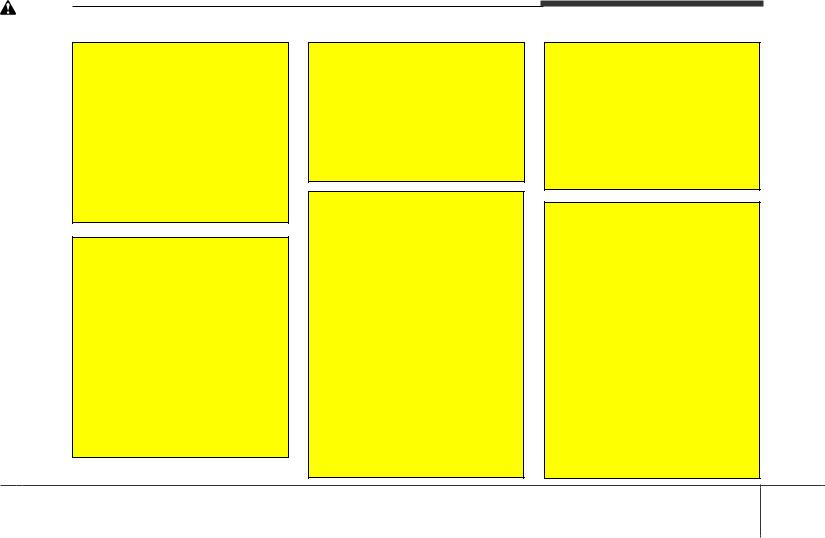
WARNING - Uprighting seat
When you return the seatback to its upright position, hold the seatback and return it slowly and be sure there are no other occupants around the seat. If the seatback is returned without being held and controlled, the back of the seat could spring forward resulting in accidental injury to a person struck by the seatback.
WARNING - Driver responsibility for passengers
Riding in a vehicle with the seatback reclined could lead to serious or fatal injury in an accident. If a seat is reclined during an accident, the occupant’s hips may slide under the lap portion of the seat belt applying great force to the unprotected abdomen. Serious or fatal internal injuries could result. The driver must advise the passenger to keep the seatback in an upright position whenever the vehicle is in motion.
 WARNING
WARNING
Do not use a sitting cushion that reduces friction between the seat and passenger. The passenger's hips may slide under the lap portion of the seat belt during an accident or a sudden stop. Serious or fatal internal injuries could result because the seat belt can't operate normally.
WARNING - Driver’s seat
•Never attempt to adjust the seat while the vehicle is moving. This could result in loss of control, and an accident causing death, serious injury, or property damage.
•Do not allow anything to interfere with the normal position of the seatback. Storing items against a seatback or in any other way interfering with proper locking of a seatback could result in serious or fatal injury in a sudden stop or collision.
•Always drive and ride with your seatback upright and the lap portion of the seat belt snug and low across the hips. This is the best position to protect you in case of an accident.
(Continued)
Safetyfeaturesofyourvehicle
(Continued)
•In order to avoid unnecessary and perhaps severe air bag injuries, always sit as far back as possible from the steering wheel while maintaining comfortable control of the vehicle. We recommend that your chest be at least 250 mm (10 inches) away from the steering wheel.
WARNING - Rear seatbacks (2nd and 3rd row)
•The rear seatback must be securely latched. If not, passengers and objects could be thrown forward resulting in serious injury or death in the event of a sudden stop or collision.
•Luggage and other cargo should be laid flat in the cargo area. If objects are large, heavy, or must be piled, they must be secured. Under no circumstances should cargo be piled higher than the seatbacks. Failure to follow these warnings could result in serious injury or death in the event of a sudden stop, collision or rollover.
(Continued)
3 3
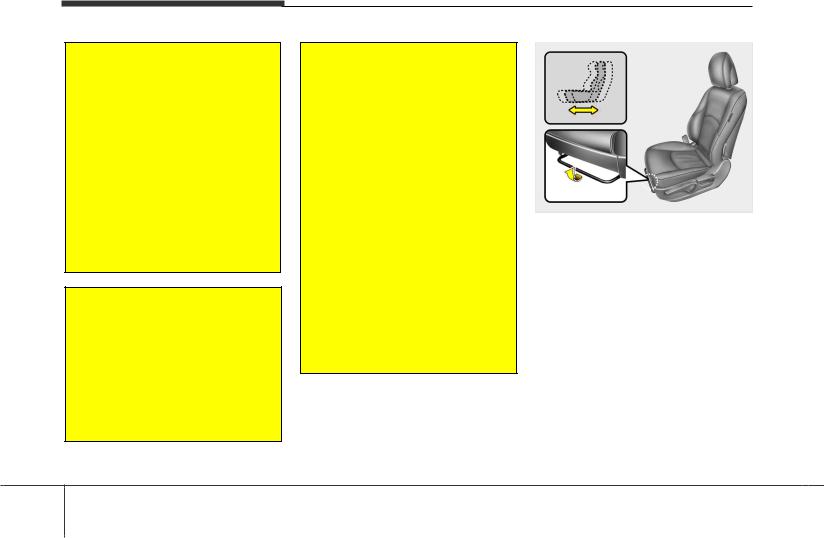
Safetyfeaturesofyourvehicle
(Continued)
•No passenger should ride in the cargo area or sit or lie on folded seatbacks while the vehicle is moving. All passengers must be properly seated in seats and restrained properly while riding.
•When resetting the seatback to the upright position, make sure it is securely latched by pushing it forward and backwards.
•To avoid the possibility of burns, do not remove the carpet in the cargo area. Emission control devices beneath this floor generate high temperatures.
 WARNING
WARNING
After adjusting the seat, always check that it is securely locked into place by attempting to move the seat forward or backward without using the lock release lever. Sudden or unexpected movement of the driver's seat could cause you to lose control of the vehicle resulting in an accident.
 WARNING
WARNING
•Do not adjust the seat while wearing seat belts. Moving the seat cushion forward may cause strong pressure on the abdomen.
•Use extreme caution so that hands or other objects are not caught in the seat mechanisms while the seat is moving.
•Do not put a cigarette lighter on the floor or seat. When you operate the seat, gas may gush out of the lighter and cause fire.
•If there are occupants in the rear seats, be careful while adjusting the front seat position.
•Use extreme caution when picking small objects trapped under the seats or between the seat and the center console. Your hands might be cut or injured by the sharp edges of the seats mechanism.
OHM038002
Front seat adjustment - manual
C010101AHM
Forward and backward
To move the seat forward or backward:
1.Pull the seat slide adjustment lever up and hold it.
2.Slide the seat to the position you desire.
3.Release the lever and make sure the seat is locked in place.
Adjust the seat before driving, and make sure the seat is locked securely by trying to move forward and backward without using the lever. If the seat moves, it is not locked properly.
3 4
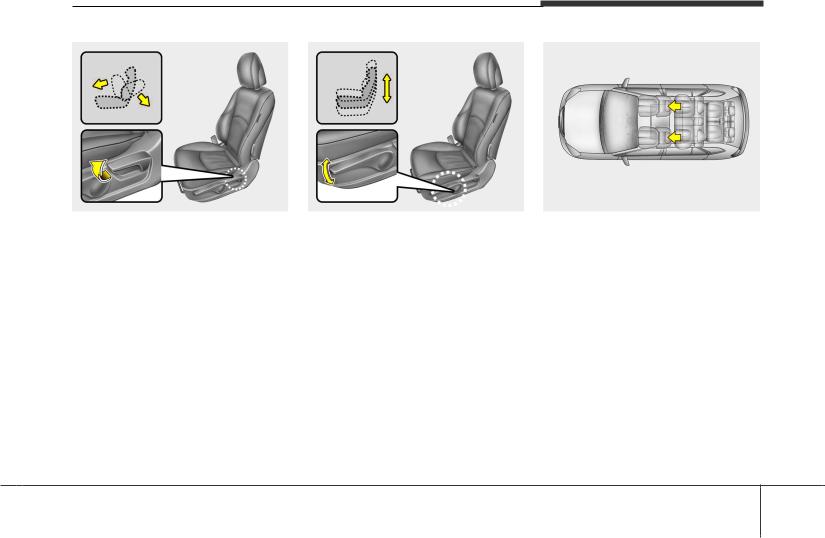
Safetyfeaturesofyourvehicle
OHM038003
C010102AHM
Seatback angle
To recline the seatback:
1.Lean forward slightly and lift up the seatback recline lever.
2.Carefully lean back on the seat and adjust the seatback of the seat to the position you desire.
3.Release the lever and make sure the seatback is locked in place. (The lever MUST return to its original position for the seatback to lock.)
OHM038004
C010103APB
Seat height (for driver’s seat)
To change the height of the seat, push the lever upwards or downwards.
•To lower the seat cushion, push down the lever several times.
•To raise the seat cushion, pull up the lever several times.
OHM038048N
C010104AHM
Headrest
The driver's and front passenger's seats are equipped with a headrest for the occupant's safety and comfort.
The headrest not only provides comfort for the driver and front passenger, but also helps protect the head and neck in the event of a collision.
3 5
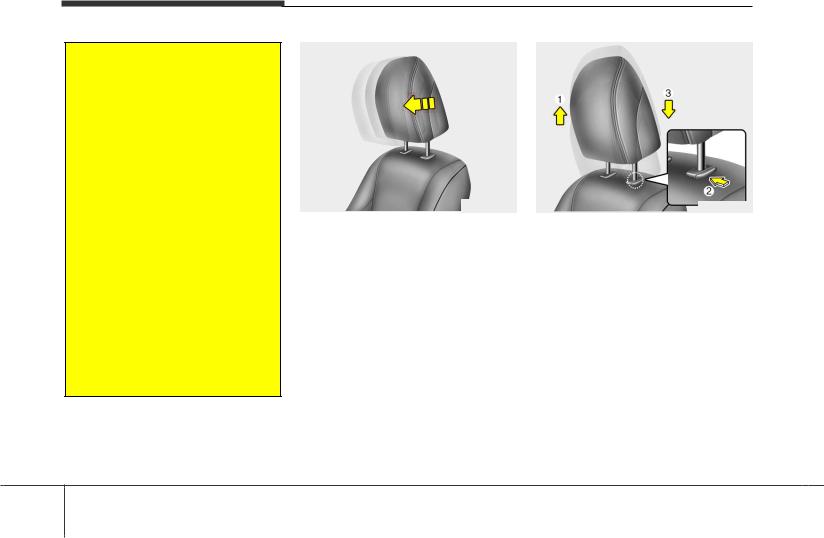
Safetyfeaturesofyourvehicle
 WARNING
WARNING
•For maximum effectiveness in case of an accident, the headrest should be adjusted so the middle of the headrest is at the same height of the center of gravity of an occupant's head. Generally, the center of gravity of most people's head is similar with the height of the top of their eyes. Also, adjust the headrest as close to your head as possible. For this reason, the use of a cushion that holds the body away from the seatback is not recommended.
•Do not operate the vehicle with the headrests removed. Severe injury to the occupants may occur in the event of an accident. Headrests may provide protection against neck injuries when properly adjusted.
•Do not adjust the headrest position of the driver’s seat while the vehicle is in motion.
OHM038005
Forwardandbackwardadjustment
The headrest may be adjusted forward to 3 different positions by pulling the headrest forward to the desired detent. To adjust the headrest to it’s furthest backward position, pull it fully forward to the farthest position and release it. Adjust the headrest so that it properly supports the head and neck.
OHM038006
Adjustingtheheightupanddown
To raise the headrest, pull it up to the desired position (1). To lower the headrest, push and hold the release button (2) on the headrest support and lower the headrest to the desired position (3).
3 6
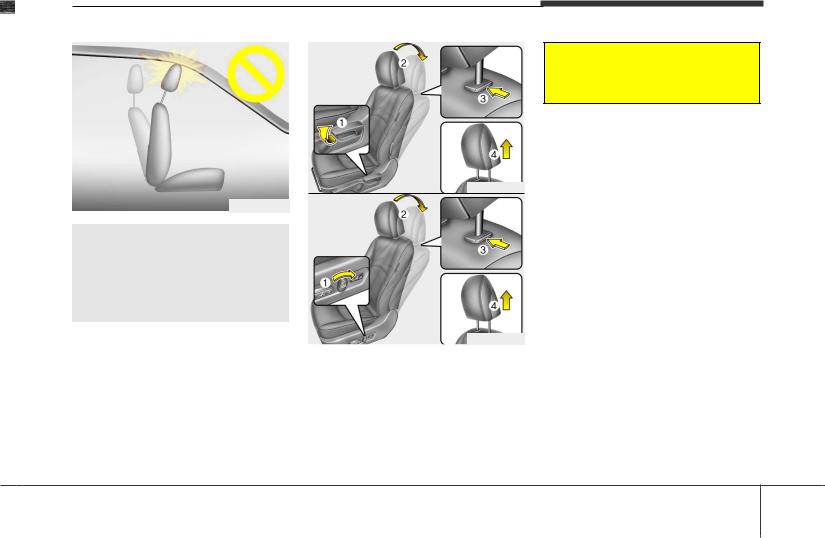
■ Type A
OHM033202
■ Type B
OYFH034205
CAUTION
If you recline the seatback towards the front with the headrest and seat cushion raised, the headrest may come in contact with the sunvisor or other parts of the vehicle.
OHM033200
Removal
To remove the headrest:
1. Recline the seatback (2) with the recline lever or switch (1).
2. Raise headrest as far as it can go.
3. Press the headrest release button (3) while pulling the headrest up (4).
Safetyfeaturesofyourvehicle
 WARNING
WARNING
NEVER allow anyone to ride in a seat with the headrest removed.
3 7

Safetyfeaturesofyourvehicle
■ Type A
OHM033203
■ Type B
OHM033201
Reinstall
To reinstall the headrest :
1.Put the headrest poles (2) into the holes while pressing the release button (1).
2.Recline the seatback (4) with the recline lever or switch (3).
3.Adjust the headrest to the appropriate height.
 WARNING
WARNING
Always make sure the headrest locks into position after reinstalling and adjusting it properly.
HNF2041-1
Activeheadrest(ifequipped)
The active headrest is designed to move forward and upward during a rear impact. This helps prevent the driver's and front passenger’s heads from moving backward and thus helps minimize neck injuries.
 WARNING
WARNING
A gap between the seat and the headrest release button may appear when seating on the seat or when you push or pull the seat. Be careful not to get your finger, etc. caught in the gap.
3 8
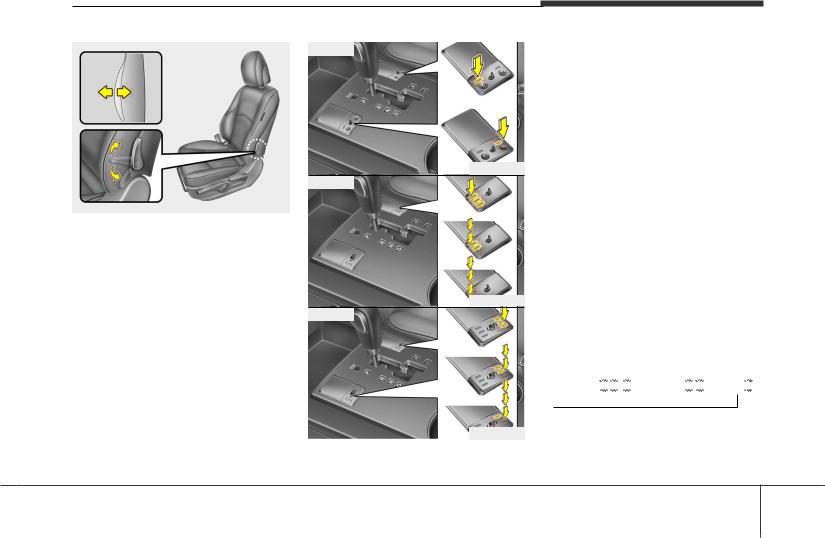
Safetyfeaturesofyourvehicle
OHM038008
C010105AHM
Lumbar support (for driver’s seat)
The lumbar support can be adjusted by moving the lever. Pivoting the lever increases or decreases lumbar support.
■ Type A
OHM038009
■ Type B
OHM034009
■ Type C
OHM034060
C010107CHM
Seat warmer (if equipped)
The seat warmers are provided to warm the front seats during cold weather. With the ignition switch in the ON position, push either of the switches to warm the driver's seat or the front passenger's seat. During mild weather or under conditions where the operation of the seat warmer is not needed, keep the switches in the OFF position.
• Type A
The temperature setting of the seat is changed as follows :
Switchposition |
Left(LO) |
Center |
Right(HI) |
|
|
|
|
Temperature |
LOW |
OFF |
HIGH |
|
|
|
|
• Type B, C
Each time you press the button, the temperature setting of the seat will chang as tollows:
OFF→HIGH( 








 )→MIDDLE(
)→MIDDLE( 




 )→LOW(
)→LOW( 


 )
)
→
3 9
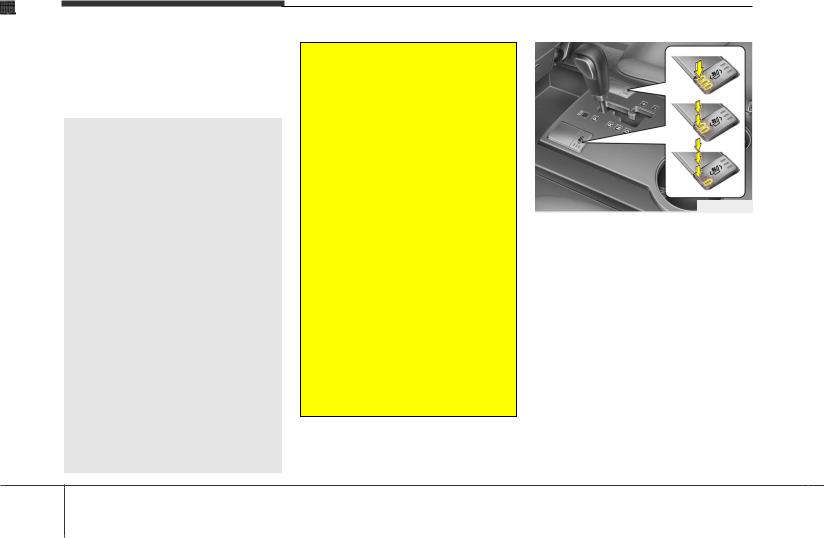
Safetyfeaturesofyourvehicle
NOTICE
With the seat warmerswitch in the ON position, the heating system in the seat turnsofforonautomaticallydepending ontheseattemperature.
CAUTION - Seat damage
•When cleaning the seats, do not use an organic solvent such as paint thinner, benzene, alcohol and gasoline. Doing so may damage the surface of the heater or seats.
•To prevent overheating the seat warmer, do not place anything on the seats that insulates against heat, such as blankets, cushions or seat covers on the seats while the seat warmer is in operation.
•Do not place heavy or sharp objects on the seat. Those things may damage the seat warmer system.
•Be careful not to spill liquid such as water or beverages on the seat. If you spill some liquid, wipe the seat with a dry towel. Before using the seat warmer, dry the seat completely.
•Do not change the seat cover. It may damage the seat warmer or airventilation system.
WARNING - Seat warmer burns
Passengers should use extreme caution when using seat warmers due to the possibility of excess heating or burns. The occupants must be able to feel if the seat is becoming too warm and to turn the seat warmer off. The seat warmer may cause burns even at low temperatures, especially if used for long periods of time.
In particular, the driver must exercise extreme care for the following types of passengers:
1.Infants, children, elderly or disabled persons, or hospital outpatients
2.Persons with sensitive skin or those that burn easily
3.Fatigued individuals
4.Intoxicated individuals
5.Individuals taking medication that can cause drowsiness or sleepiness (sleeping pills, cold tablets, etc.)
OHM034001
C010109BHM
Air ventilation seat (if equipped)
The air ventilation seat is provided to cool the driver’s seat or front passenger’s seat (if equipped) during hot weather by blowing air through small vent hole on the surface of the seat and seatback.
3 10
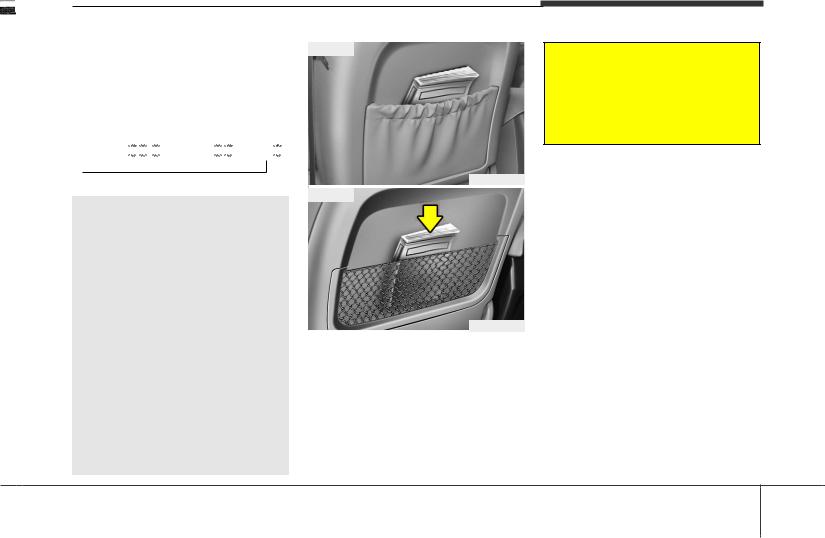
Safetyfeaturesofyourvehicle
While the engine is running, push the left portion of the button to cool the front seat. When the operation of the air ventilation seat is not needed, keep the buttons in the OFF position.
•Each time you push the button, the airflow is changed as follows:
OFF→HIGH( 








 )→MIDDLE(
)→MIDDLE( 




 )→LOW(
)→LOW( 


 )
)
→
CAUTION - Seat damage
•When cleaning the seats, do not use an organic solvent such as paint thinner, benzene, alcohol and gasoline. Doing so may damage the air ventilation seat.
•Do not place heavy or sharp objects on the seat. Those things may damage the air ventilation seat.
•Be careful not to spill liquid such as water or beverages on the seat. If you spill some liquid, wipe the seat with a dry towel. Before using the air ventilation seat, dry the seat completely.
•Do not change the seat cover. It may damage the seat warmer or
airventilation system.
■ Type A
OHM038010
■ Type B
OXM039015
C010108AHM
Seatback pocket
WARNING - Seatback pockets
Do not put heavy or sharp objects in the seatback pockets. In an accident they could come loose from the pocket and injure vehicle occupants.
3 11
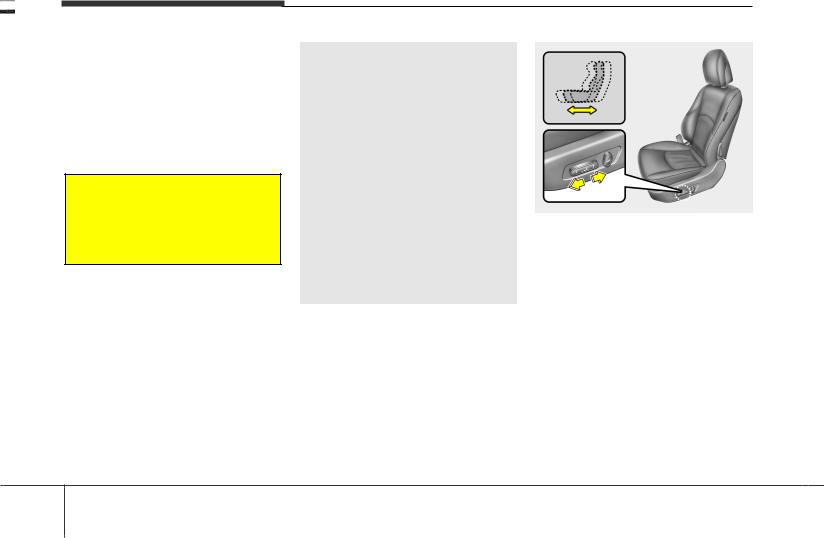
Safetyfeaturesofyourvehicle
C010200AHM
Front seat adjustment - power (if equipped)
The front seat can be adjusted by using the control switches located on the outside of the seat cushion. Before driving, adjust the seat to the proper position so as to easily control the steering wheel, pedals and switches on the instrument panel.
 WARNING
WARNING
The power seat is operable with the ignition OFF.
Therefore, children should never be left unattended in the vehicle.
CAUTION
•The power seat is driven by an electric motor. Stop operating once the adjustment is completed. Excessive operation may damage the electrical equipment.
•When in operation, the power seat consumes a large amount of electrical power. To prevent unnecessary charging system drain, don’t adjust the power seat longer than necessary while the engine is not running.
•Do not operate two or more power seat control switches at the same time. Doing so may result in power seat motor or electrical component malfunction.
OHM038011L
C010201AHM
Forward and backward
Push the control switch forward or backward to move the seat to the desired position. Release the switch once the seat reaches the desired position.
3 12
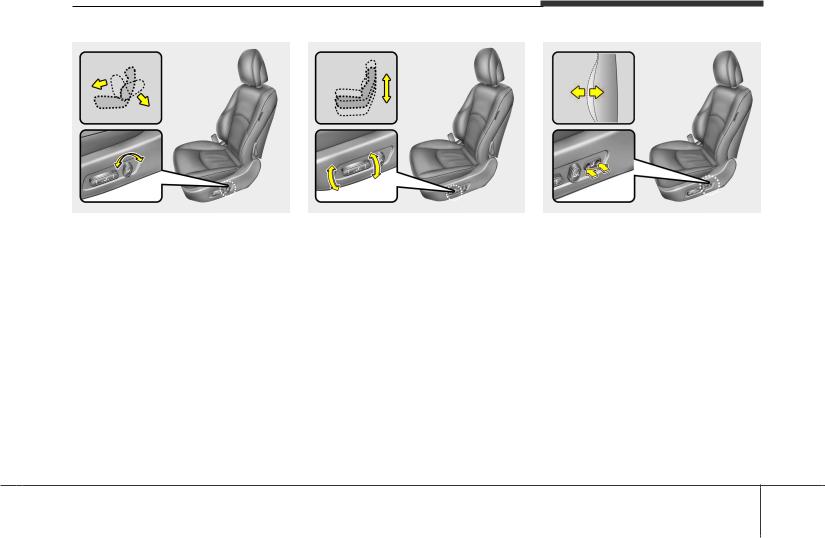
Safetyfeaturesofyourvehicle
OHM038012L
C010202AHM
Seatback angle
Push the control switch forward or backward to move the seatback to the desired angle. Release the switch once the seat reaches the desired position.
OHM038013L
C010203AHM
Seat height (for driver’s seat)
Pull the front portion of the control switch up to raise or down to lower the front part of the seat cushion. Pull the rear portion of the control switch up to raise or down to lower the rear part of the seat cushion. Release the switch once the seat reaches the desired position.
OHM038014
C010204AHM
Lumbar support
(for driver’s seat, if equipped)
The lumbar support can be adjusted by pressing the button.
3 13
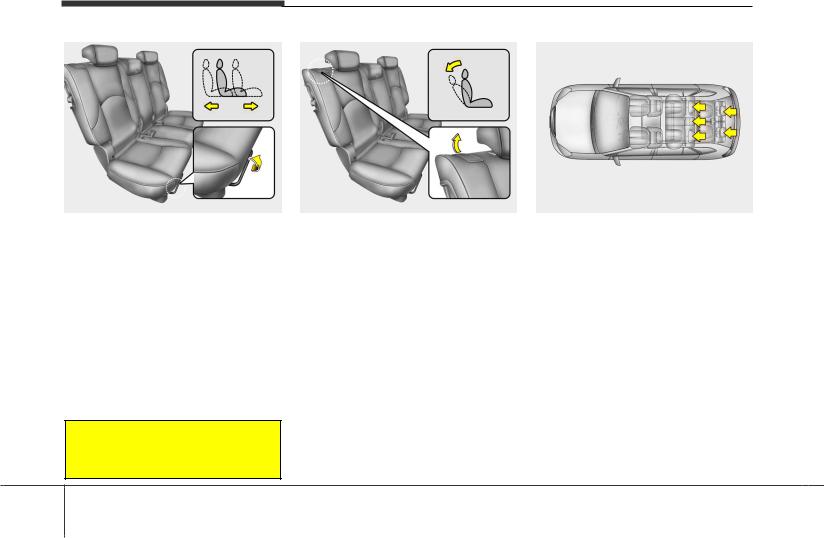
Safetyfeaturesofyourvehicle
OHM038015
Rear seat adjustment
C010301AHM
Forward and backward (2nd row seat)
To move the seat forward or backward:
1.Pull up the seat slide adjustment lever and hold it.
2.Slide the seat to the position you desire.
3.Release the lever and make sure the seat is locked in place.
Adjust the seat before driving, and make sure the seat is locked securely by trying to move forward and backward without using the lever. If the seat moves, it is not locked properly.
 WARNING
WARNING
Do not put your hands underneath the seat while adjusting it.
OHM038016
C010302AHM
Seatback angle
To recline the seatback:
1.Pull up the seatback recline lever.
2.Hold the lever and adjust the seatback of the seat to the position you desire.
3.Release the lever and make sure the seatback is locked in place. (The lever MUST return to its original position for the seatback to lock.)
OHM038049N
C010303BHM
Headrest
The rear seat(s) is equipped with headrests in all the seating positions for the occupant's safety and comfort.
The headrest not only provides comfort for passengers, but also helps protect the head and neck in the event of a collision.
3 14
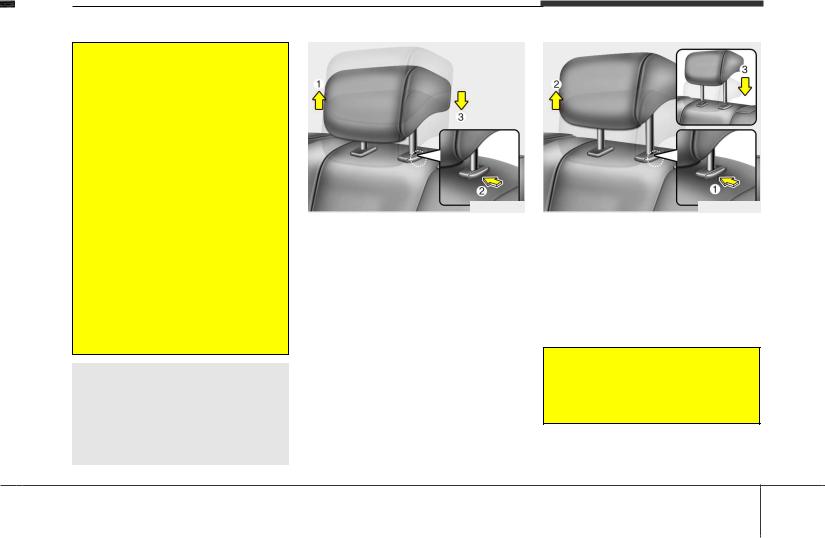
 WARNING
WARNING
•For maximum effectiveness in case of an accident, the headrest should be adjusted so the middle of the headrest is at the same height of the center of gravity of an occupant's head. Generally, the center of gravity of most people's head is similar with the height of the top of their eyes. Also adjust the headrest as close to your head as possible. For this reason, the use of a cushion that holds the body away from the seatback is not recommended.
•Do not operate the vehicle with the headrests removed. Severe injury to an occupant may occur in the event of an accident. Headrests may provide protection against severe neck injuries when properly adjusted.
CAUTION
When there is no occupant in the rear seats, adjust the height of the headrest to the lowest position. The rear seat headrest can reduce the visibility of the rear area.
Safetyfeaturesofyourvehicle
OHM038017
Adjustingtheheightupanddown
To raise the headrest, pull it up to the desired position (1). To lower the headrest, push and hold the release button (2) on the headrest support and lower the headrest to the desired position (3).
OHM038018N
Removal
To remove the headrest, raise it as far as it can go then press the release button
(1) while pulling the headrest up (2).
To reinstall the headrest, put the headrest poles (3) into the holes while pressing the release button (1). Then adjust it to the appropriate height.
 WARNING
WARNING
Make sure the headrest locks in position after adjusting it to properly protect the occupants.
3 15
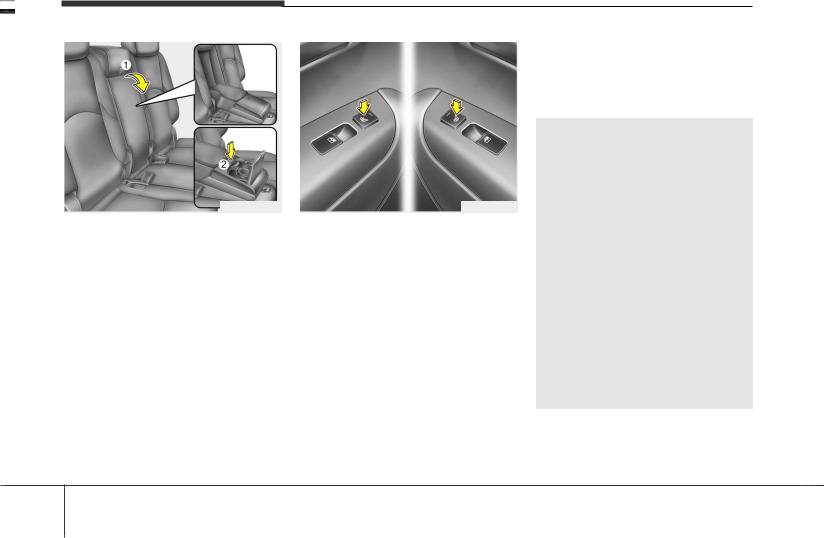
Safetyfeaturesofyourvehicle
OHM038019A
C010304AHM
Armrest (2nd row seat)
To use the armrest, pull the strap (1) forward from the seatback.
Cupholder
To use the cup holder, push the button
(2). Close the cover after use.
OHM038021
C010305BHM
Seat warmer (2nd row, if equipped)
The seat warmers are provided to warm the rear seats during cold weather. With the ignition switch in the ON position, push either of the switches to warm the left or right side of the seat.
During mild weather or under conditions where the operation of the seat warmer is not needed, keep the switches in the OFF state.
•The seat warmer defaults to the OFF state whenever the ignition switch is turned on.
NOTICE
With the seat warmerswitch in the ON state, the heating system in the seat turnsofforonautomaticallydepending ontheseattemperature.
CAUTION
•When cleaning the seats, do not use an organic solvent such as thinner, benzene, alcohol and gasoline. Doing so may damage the surface of the heater or seats.
•To prevent overheating the seat warmer, do not place blankets, cushions or seat covers on the seats while the seat warmer is in operation.
•Do not place heavy or sharp objects on seats equipped with seat warmers. Damage to the seat warming components could occur.
•Always turn off the seat warmer when not in use.
•Do not change the seat cover. It may damage the seat warmer or airventilation system.
3 16
